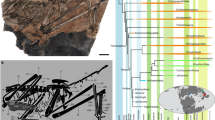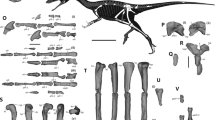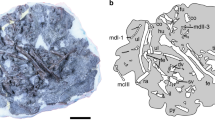Abstract
Archaeopteryx is widely accepted as being the most basal bird, and accordingly it is regarded as central to understanding avialan origins; however, recent discoveries of derived maniraptorans have weakened the avialan status of Archaeopteryx. Here we report a new Archaeopteryx-like theropod from China. This find further demonstrates that many features formerly regarded as being diagnostic of Avialae, including long and robust forelimbs, actually characterize the more inclusive group Paraves (composed of the avialans and the deinonychosaurs). Notably, adding the new taxon into a comprehensive phylogenetic analysis shifts Archaeopteryx to the Deinonychosauria. Despite only tentative statistical support, this result challenges the centrality of Archaeopteryx in the transition to birds. If this new phylogenetic hypothesis can be confirmed by further investigation, current assumptions regarding the avialan ancestral condition will need to be re-evaluated.
This is a preview of subscription content, access via your institution
Access options
Subscribe to this journal
Receive 51 print issues and online access
$199.00 per year
only $3.90 per issue
Buy this article
- Purchase on Springer Link
- Instant access to full article PDF
Prices may be subject to local taxes which are calculated during checkout




Similar content being viewed by others
References
Feduccia, A. The Origin and Evolution of Birds 2nd edn (Yale Univ. Press, 1999)
Zhou, Z.-H. The origin and early evolution of birds: discoveries, disputes, and perspectives from fossil evidence. Naturwissenschaften 91, 455–471 (2004)
Witmer, L. M. in Mesozoic Birds: Above the Heads of Dinosaurs (eds Chiappe, L. M. & Witmer, L. M. ) 3–30 (Univ. California Press, 2002)
Zhang, F. C. et al. A bizarre Jurassic maniraptoran from China with elongate ribbon-like feathers. Nature 455, 1105–1108 (2008)
Xu, X. et al. A new feathered maniraptoran dinosaur fossil that fills a morphological gap in avian origin. Chin. Sci. Bull. 54, 430–435 (2009)
Hu, D. Y. et al. A pre-Archaeopteryx troodontid from China with long feathers on the metatarsus. Nature 461, 640–643 (2009)
Xu, K. et al. Jurassic System in the North of China (VII): the Stratigraphic Region of Northeast China (Petroleum Industry Press, Beijing, 2003)
Tamura, K. et al. Embryological evidence identifies wing digits in birds as digits 1, 2, and 3. Science 331, 753–757 (2011)
Christiansen, P. & Fariña, R. A. Mass prediction in theropod dinosaurs. Hist. Biol. 16, 85–92 (2004)
Turner, A. H. et al. A basal dromaeosaurid and size evolution preceding avian flight. Science 317, 1378–1381 (2007)
Xu, X. Deinonychosaurian Fossils from the Jehol Group of Western Liaoning and the Coelurosaurian Evolution. PhD thesis, Chinese Academy of Sciences. (2002)
Osmólska, H., Currie, P. J. & Barsbold, R. in The Dinosauria 2nd edn (eds Weishampel, D. B., Dodson, P. & Osmólska, H. ) 165–183 (Univ. California Press, 2004)
Makovicky, P. J. & Norell, M. A. in The Dinosauria 2nd edn (eds Weishampel, D. B., Dodson, P. & Osmólska, H. ) 184–195 (Univ. California Press, 2004)
Makovicky, P. J., Apesteguı’a, S. & Agnolı’n, F. L. The earliest dromaeosaurid theropod from South America. Nature 437, 1007–1011 (2005)
Chiappe, L. M. et al. Anatomy and systematics of the Confuciusornithidae (Theropoda: Aves) from the late Mesozoic of Northeastern China. Bull. Am. Mus. 242, 1–89 (1999)
Wellnhofer, P. Archaeopteryx-Der urvogel von Solnhofen (Friedrich Pfeil, 2008)
Zhou, Z. H. & Zhang, F. C. Anatomy of the primitive bird Sapeornis chaoyangensis from the Early Cretaceous of Liaoning, China. Can. J. Earth Sci. 40, 731–747 (2003)
Norell, M. A. & Makovicky, P. J. in The Dinosauria 2nd edn (eds Weishampel, D. B., Dodson, P. & Osmólska, H. ) 196–209 (Univ. California Press, 2004)
Ji, Q., Currie, P. J., Norell, M. A. & Ji, S.-A. Two feathered dinosaurs from northeastern China. Nature 393, 753–761 (1998)
Fröbisch, J. & Reisz, R. R. The Late Permian herbivore Suminia and the early evolution of arboreality in terrestrial vertebrate ecosystems. Proc. R. Soc. Lond. B 276, 3611–3618 (2009)
Gauthier, J. Saurischian monophyly and the origin of birds. Memoirs Cal. Acad. Sci. 8, 1–55 (1986)
Paul, G. Predatory Dinosaurs of the World (Simon & Schuster, 1988)
Xu, X. et al. Four-winged dinosaurs from China. Nature 421, 335–340 (2003)
Sereno, P. C. The evolution of dinosaurs. Science 284, 2137–2147 (1999)
Holtz, T. R. Jr. A new phylogeny of the carnivorous dinosaurs. Gaia 15, 5–61 (2000)
Norell, M. A., Clark, J. M. & Makovicky, P. J. in New Perspectives on the Origin and Evolution of Birds (eds Gauthier, J. & Gall, L. F. ) 49–67 (Yale Univ. Press, 2001)
Choiniere, J. N. et al. A basal alvarezsauroid theropod from the early Late Jurassic of Xinjiang, China. Science 327, 571–574 (2010)
Mayr, G. et al. The tenth skeletal specimen of Archaeopteryx . Zool. J. Linn. Soc. 149, 97–116 (2007)
Holtz, T. R. J. in New Perspectives on the Origin and Early Evolution of Birds (eds Gauthier, J. A. & Gall, L. F. ) 99–124 (Peabody Museum of Natural History, 2001)
Luo, Z. X. Transformation and diversification in early mammal evolution. Nature 450, 1011–1019 (2007)
Mayr, G., Pohl, B. & Peters, S. A well-preserved Archaeopteryx specimen with theropod features. Science 310, 1483–1486 (2005)
Hu, D.-Y. et al. A new sapeornithid bird from China and its implication for early avian evolution. Acta Geol. Sin. 84, 472–482 (2010)
Xu, X., Norell, M. A., Wang, X.-l., Makovicky, P. J. & Wu, X.-c. A basal troodontid from the Early Cretaceous of China. Nature 415, 780–784 (2002)
Hwang, S. H. et al. New specimens of Microraptor zhaoianus (Theropoda: Dromaeosauridae) from northeastern China. Am. Mus. Novit. 3381, 1–44 (2002)
Zheng, X. T. The Origin of Birds (Shandong Science and Technology Press, 2009)
Novas, F. E. & Puerta, P. F. New evidence concerning avian origins from the Late Cretaceous of Patagonia. Nature 387, 390–392 (1997)
Forster, C. A. et al. The theropod ancestry of birds: new evidence from the Late Cretaceous of Madagascar. Science 279, 1915–1919 (1998)
Xu, X., Ma, Q.-Y. & Hu, D.-Y. Pre-Archaeopteryx coelurosaurian dinosaurs and their implications for understanding avian origins. Chin. Sci. Bull. 55, 3971–3977 (2010)
Rauhut, O. W. M. The interrelationships and evolution of basal theropod dinosaurs. Palaeontology 69, 1–215 (2003)
Senter, P. A new look at the phylogeny of Coelurosauria (Dinosauria:Theropoda). J. Syst. Palaeontology 5, 1–35 (2007)
Novas, F. E. in Feathered Dragons, Studies on the Transition From Dinosaurs to Birds (eds Currie, P. J., Koppelhaus, E. B., Shugar, M. A. & Wright, J. L. ) 150–168 (Indiana Univ. Press, 2004)
Maryanska, T., Osmólska, H. & Wolsan, M. Avialan status for Oviraptorosauria. Acta Palaeontol. Pol. 47, 97–116 (2002)
Zanno, L. E. et al. A new North American therizinosaurid and the role of herbivory in “predatory” dinosaur evolution. Proc. R. Soc. Lond. B 276, 3505–3511 (2009)
Zanno, L. E. & Makovicky, P. J. Herbivorous ecomorphology and specialization patterns in theropod dinosaur evolution. Proc. Natl Acad. Sci. USA 108, 232–237 (2011)
Acknowledgements
The authors thank X. Zheng for permission to study the holotype specimen of Xiaotingia zhengi and for discussions; P. Chen, L. Hou and Z. Zhou for coordinating the project; C. Sullivan for editing and commenting on the manuscript; R. Li for illustrations; T. Yu for preparing the specimen; X. Ding for editing the illustrations; D. Pol for help in using the TNT software package; P. Barrett, O. Rauhut, M. Kölbl-Ebert and M. Röper for facilitating access to the Archaeopteryx specimens under their care; and G. Mayr for discussions. This work was supported by grants from the National Natural Science Foundation of China, Chinese Academy of Sciences, and Special Funds for Major State Basic Research Projects of China.
Author information
Authors and Affiliations
Contributions
X.X. designed the project, X.X., H.Y., K.D. and F.H. performed the research, and X.X. wrote the manuscript.
Corresponding author
Ethics declarations
Competing interests
The authors declare no competing financial interests.
Supplementary information
Supplementary Information
This file contains Supplementary Text (see contents list for details), Supplementary Figures 1-11 with legends, Supplementary Table 1, a Supplementary Character list, a Supplementary Matrix and additional refernces. (PDF 1639 kb)
Rights and permissions
About this article
Cite this article
Xu, X., You, H., Du, K. et al. An Archaeopteryx-like theropod from China and the origin of Avialae. Nature 475, 465–470 (2011). https://doi.org/10.1038/nature10288
Received:
Accepted:
Published:
Issue Date:
DOI: https://doi.org/10.1038/nature10288
This article is cited by
-
The developing bird pelvis passes through ancestral dinosaurian conditions
Nature (2022)
-
The first draft genome of Picrorhiza kurrooa, an endangered medicinal herb from Himalayas
Scientific Reports (2021)
-
Genetic diversity and population structure of advanced clones selected over forty years by a potato breeding program in the USA
Scientific Reports (2021)
-
The grapevine (Vitis vinifera L.) floral transcriptome in Pinot noir variety: identification of tissue-related gene networks and whorl-specific markers in pre- and post-anthesis phases
Horticulture Research (2021)
-
Molecular phyloecology suggests a trophic shift concurrent with the evolution of the first birds
Communications Biology (2021)
Comments
By submitting a comment you agree to abide by our Terms and Community Guidelines. If you find something abusive or that does not comply with our terms or guidelines please flag it as inappropriate.



